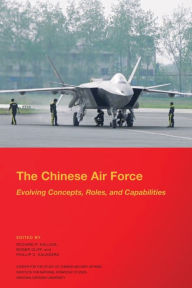The Chinese Air Force: Evolving Concepts, Roles, and Capabilities Institute for Nationa
by Strategic Studies
2020-05-26 19:54:10
The Chinese Air Force: Evolving Concepts, Roles, and Capabilities Institute for Nationa
by Strategic Studies
2020-05-26 19:54:10
The ever-accelerating transformation of the People's Republic of China (PRC) in the years since the era of Mao Zedong, particularly in its economic and military growth, has been nothing short of remarkable. Developments over the last quarter-century-...
Read more
The ever-accelerating transformation of the People's Republic of China (PRC) in the years since the era of Mao Zedong, particularly in its economic and military growth, has been nothing short of remarkable. Developments over the last quarter-century-effectively since the tragedy of Tiananmen Square and the collapse of the Soviet Union and Warsaw Pact alliance-have been more so still. The relationship of this increasingly robust and growing power to the established global community is a complex one, and no thornier aspect of that relationship can be found than the uneasy interplay among the PRC, Taiwan, and the countries that deal with both.It should come as no surprise that the concept of airpower has changed a great deal since H.G. Wells first used the term in his 1908 science fiction novel, The War in the Air. Given the passage of more than a century, the world has seen dramatic advances in technology as well as changes in the geopolitical conditions in which war is fought. Yet within the ever-evolving fabric of airpower history, one can find remarkable threads of continuity. Early aircraft, though but fragile contraptions of wood and canvas, exploited the same advantages enjoyed by the sophisticated weapons systems that operate in today's 21st-century skies: the ability to cover great distances in any direction quickly, free of obstruction by surface terrain; the ability to overfly enemy armies and navies and attack them from above, across the breadth and depth of the battlespace; and the ability to take war to the heart of an enemy's society, striking vulnerable targets previously unreachable before defeating surface defenses. So there should be little wonder that the concept of airpower, while ever evolving, has also exhibited elements of continuity, as have the doctrines and strategies that conceptual thinking about airpower has inspired. In many ways and for reasons that are clearly evident, today's airmen have inherited the strategic mindset of their forebears.This paper examines that mindset in historical context as it traces the evolution of airpower thought and considers what theoretical, technological, and political trends suggest for strategies that air forces will likely employ in the future. It explains how airpower thought, though buffeted by changes in technology and geopolitics, has been anchored on an evolving body of theory conceived to exploit the unique warfighting advantages afforded by the ability of aircraft to operate in the vertical dimension. Yet within this unifying framework, strategic thinkers have, from the earliest days of military air operations, debated whether airpower is employed most effectively as an independent instrument against targets chosen to create direct, war-winning effects at the strategic level of war, or whether it is better used in combination with surface forces at the operational level of war. I argue that these competing ideas appear to be converging in the current era, but the debate is unlikely to ever be fully resolved. That is a good thing because strategy has always benefited from rigorous examination and spirited intellectual debate. Creative thought and innovation have always been the touchstones of airpower. That heritage will continue into the future.
Less


























.jpg)



